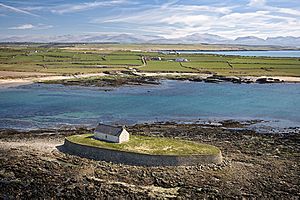St Cwyfan's Church, Llangwyfan facts for kids
Quick facts for kids St Cwyfan's Church |
|
|---|---|
|
Eglwys Cwyfan (Welsh)
|
|
 |
|
| Country | Wales, United Kingdom |
| Denomination | Church in Wales |
| Architecture | |
| Heritage designation | Grade II* |
| Architectural type | Church |
| Style | Medieval |
St Cwyfan's Church (Welsh: Eglwys Cwyfan) is a Grade II*-listed medieval church in Llangadwaladr, Anglesey, Wales. Located on the small tidal island of Cribinau, it is popularly known as the "Little Church in the Sea" (or Eglwys fach y môr in Welsh). The church dates from the 12th century, with some renovations made in the 19th century.
History and architecture
Dating from the 12th century, St Cwyfan's Church is dedicated to Saint Kevin, who founded the monastery at Glendalough in County Wicklow, Ireland. The church originally stood at the end of a peninsula between two bays, Porth Cwyfan and Porth China. In later years the sea slowly eroded around the coast in the two bays, therefore the peninsula was cut off, turning Cribinau into a small tidal island. As a consequence, a causeway was built to the island to allow the local population to get to the church.
In 1766 the Bishop of Bangor appointed Thomas Bowles as the parish priest of Trefdraeth, which included St Cwyfan's Church. Bowles spoke no Welsh, and only five of the 500 church-goers understood English. As a result, they protested against his appointment and the case was heard in an ecclesiastical court in 1773. The judge ruled that Welsh-speaking priests should be sent to primarily Welsh-speaking parishes.
The waves continued to erode Cribinau until the late 19th century, when some of the graves surrounding the church began to fall into the sea. During this time the church fell into disrepair; the walls became disused and roofless, and the church was consequently replaced by a new building further inland in Llangwyfan. However, in 1893 a local architect, Harold Hughes, raised money to save the church by constructing a seawall around the Cribinau, and for the restoration of the building.
Current use
The church remains in use and is popular for weddings and baptisms.

